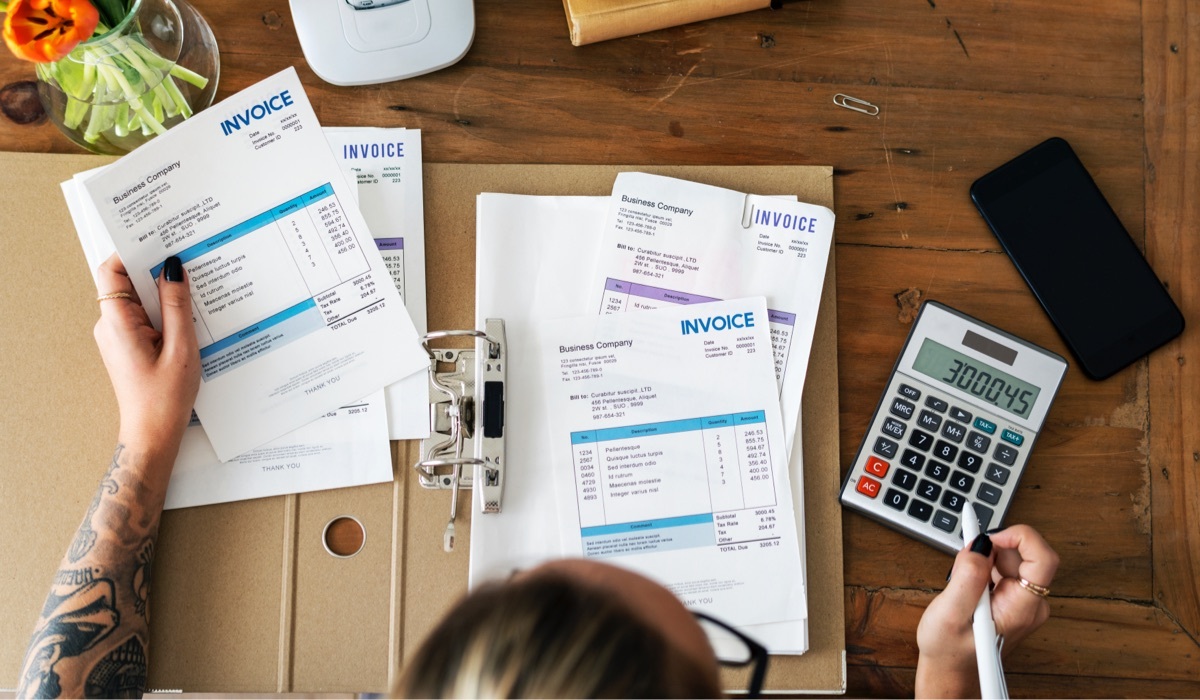Invoice Number — What You Need to Know
Sending invoices is an important and essential part of doing business: it is, after all, how you get paid (by facilitating the accounts payable process of your client). Therefore, managing your invoicing process well is important for managing the financial health of your business. In this article, we discuss one key element in an invoice: the invoice number.

What is an invoice number? Why is it important? What format should it take? These are some of the questions we will answer in detail. Note that this is a supplementary article to our guide on how to write an invoice.
What is an Invoice Number?
The invoice number—sometimes referred to as the Invoice ID–is a unique number or code assigned to each invoice that you send. The purpose of the invoice number is to identify the particular invoice among all the invoices sent out by you.
The invoice number can be alphanumeric, and may sometimes use special characters like the dash or hyphen. Together with the other details in the invoice, such as the sender’s business name and contact details, the invoice number makes it easier for both the vendor and the client to refer to the financial transaction without any misunderstandings.
A better way to manage your finances
With Hiveage you can send elegant invoices to your customers, accept online payments, and manage your team — all in one place.
For example, two of your clients might purchase the exact same product or service. You would be able to easily identify each transaction simply by the associated invoice number, without having to look into other details of the invoice. Your clients will also be able to communicate with you about their payments etc. easily by referring to the number on the invoice they have received from you.
Why is Invoice Numbering Important?
As we have already pointed out, invoice numbers are essential in order to find and identify your transactions with ease. In the process of doing business, you will be sending out numerous documents, including quotes, bills, and purchase orders. The easiest way to reference each of these would be the numbers or IDs you assign to them—for invoices, it would be the invoice ID.
In many jurisdictions, it is also a legal requirement to have the invoices numbered. They may even require a specific sequence to be assigned as your invoice numbering system. Before giving invoice numbers to your business or each project, please check with your country or state’s legal and professional requirements.
Invoice numbering is also essential for your accounting system. Whether you use professional accounting services or hire an internal bookkeeper, they are going to require invoice numbers to manage your financial records.
What Does an Invoice Number Look Like?
To keep track of your invoicing, each invoice should have a unique number that follows a sequence. Thus, each invoice number will be distinct, but there will be an easily understandable sequence for how they are assigned to invoices.
An invoice number may be purely a number, or a combination of numbers and letters, and the exact make-up depends on how you choose to organize and assign invoice numbers. For example, if you organize your invoices by year, a number could read 2020-2435: the first four digits here is based on the year, and the rest of the code represents where the invoice falls in the sequence. If you use an online invoicing software like Hiveage, this invoice number sequence can be defined once and then automatically managed for you when creating invoices.
Where Do I Find the Invoice Number?
The layout of the invoices vary between vendors, but they all follow a common general standard. An invoice will include your company name, the client’s name, the date of the invoice, date(s) when payment(s) is due, the total payable amount, the products or services that have been offered, taxes and other fees . . . and the invoice number.
The invoice number should appear somewhere that is easy to find, usually at the top of the invoice. Their placement should be consistent across your invoices so that both you and the customer do not have to search for it. Some invoices could have the number in several spots on the invoice, but this is not a requirement.
What Invoice Number Should I Start With?
There is no specific rule on how to set up your invoice number format. In a later section we will discuss several options. If you use an online invoicing software like Hiveage, you will have the option of choosing from a set of standard options, or defining your own. The software will also take care of automatically incrementing the invoice number sequence, so that you never accidentally duplicate the number of invoices.
Is the Invoice Number the Same as the Bill Number?
Note that an invoice number is different from a bill number. A bill number is the total sum of money owed to your company. The sum of money on the bill comes from the total of all the invoices.
For example, let's say you are doing a project that requires materials from several companies. When the job is done, you must invoice your customer for all the materials plus labor. Each of these items can be on their own invoice, with their own invoice number. It would be more convenient to then create a single bill with all those figures, with its own number, so that the client can refer to a single document instead of multiple, separate invoices.
What is an Invoice Copy?
An invoice copy is just what it sounds like: it is simply a copy of an existing invoice, used to generate the details for an identical transaction. For example, if you have a customer who routinely purchases the same product or service, instead of creating new invoices for each purchase, you can simply create a copy of the original invoice. Then the items purchased, quantity, price, and tax will remain the same.
In Hiveage we facilitate this with the “Duplicate Invoice” feature.
Best Practices when Dealing with Invoice Numbers
The following are a few tips for generating your invoicing numbers: they will make the communication between your customers and you easier and less ambiguous.
Do’s
- Make certain your invoice numbers are ordered sequentially
- Create a number format that makes sense now and in the future
- Use invoicing software whenever possible (Hiveage even offers a free plan)
- Check your local laws for financial record-keeping
- Make invoice number easy to find on the invoice
- Put the invoice number in the same place on each invoice (usually in the invoice header)
- Include the invoice number on all requests for payment from your client to facilitate easier communication and accounting
- Keep your invoice layout and structure consistent
- Include the date when payments are due and have future invoicing follow a proper sequence
Don’ts
- Don’t make the invoice number format too complicated
- Don’t arbitrarily assign invoice numbers
- Don’t change the invoice number mid-transaction
Different Ways to Organize Your Invoice Numbers
There is no one size fits all approach to an invoice numbering system. This is true even if you use invoicing software.
The following are some common methods you can use to assign invoice numbers. Find the one that works for you and then stick to it. Continually changing your unique invoice number methodology creates confusion for you and your customers.

Simple Sequence Invoice Numbering System
The simplest way to number your invoices would be to start from 1 and increment onwards for subsequent invoices. It is a common practice to make the invoice number a few digits long, so this could appear as 001, 002, 003 and so on. You can also add a prefix for the invoices, to separate them from other types of documents (e.g., estimates). The default option in Hiveage uses INV as the invoice number prefix for invoices. A simple invoice number sequence based on the above would be: INV-001, INV-002, INV-003 . . .
Assign Invoice Numbers By Client
One option you can choose is to give each client a unique code. For example, it may be a number like 760 or a letter code based on the client name. Every time you are invoicing that particular client, 760 can be the prefix in the invoice number. The first invoice number for that client could be 760-001, with the subsequent numbers being 760-002, 760-003, and so on.
Invoice Numbers By Date or Year
Another common way to create invoice numbers is by date. This can be a straightforward way to help keep track of your invoices while also indicating when the invoices were issued. One such option is to use the date as a prefix, in YYYYMMDD format (e.g., 20201025-001).
This, however, makes for long invoice numbers. You can opt to make them shorter by simply using the year as a prefix. Such a sequence might take the form of 2020-001, 2020-002 and so on.
Invoice Numbers by Project
If you do project-based work, another way to format your invoice number is to have a project code as the prefix. Thus, this requires each of your projects to have a unique code as well. Then, each of the invoices raised for that particular project can have the project code as the invoice number prefix.
For example, if the project code is WAB25, the invoice number sequence for that project would take the form of WAB25-001, WAB25-002 and so on.
Much of this work can be easily automated by using invoicing software like Hiveage: you can simply set up the invoice number format with any of the above options, and then continue creating your invoices without having to bother about generating the correct number for each invoice. This way, your invoices are always numbered systematically, making it easy to find and update an invoice.
How to Use Invoice Numbers in Other Statements
Invoice numbers are likely to appear in various other documents in addition to the final invoice. This allows you to identify all the records that are associated with a specific job.
For example, let's say you prepare an estimate for a client. They take the job, and now you want to track and identify a purchase related to that job. All invoices created for the job would then need to refer to the purchase order by mentioning its number. Additionally, once they send a final payment or a partial payment, you want to be certain your records are updated. Wherever the transaction related to the invoice is recorded, you would want to have the correct invoice number mentioned for easy cross-referencing.
How Invoice Numbers Work in Hiveage
Invoicing software can be the easiest way to handle invoice numbering. Hiveage lets you define an invoice numbering format for your invoices, and will automatically increment it every time you create a new invoice. This eliminates the hassle of having to keep track of your numbering sequence, and lets you focus on the key elements of the invoice: the client and the products or services you are billing for. Everything else, including taxes, discounts, shipping charges and payment methods, can be preset and automatically applied for all your invoices.
Hiveage also supports recurring billing, where you can set up a regular schedule of invoices for a particular client (e.g., monthly or yearly subscriptions). In such instances, Hiveage can either use the next available invoice number when generating those automated invoices, or you can define a separate invoice numbering sequence for the recurring billing schedule. Thus, you can have both a default invoice number sequence, and recurring profiles that adhere to it or use their own sequences.
One limitation in Hiveage at the moment is separate, project-based invoice number sequences (when they are not related to a recurring profile). This is one of the upcoming features currently in our product roadmap, as of this writing.
Automating the invoice number is just one among many convenient features in Hiveage that makes managing your finances simple and easy. Our goal, as always, is to reduce these administrative hassles so that you can focus on growing your freelance career or small business. Try Hiveage by signing up for a full-featured free trial (no credit card required), and see how your invoicing can be made so much easier.
FAQs on Invoice Number Format
What is an invoice number?
It is a unique number that is assigned to each of your invoices. Professional invoices have sequential invoice numbers. Make sure to avoid duplicate invoice numbers. Most accounting software automate this process for you.
Do I need an invoice number?
Yes, due to accounting, legal and tax purposes, assigning invoice numbers is essential.
How do I find an invoice number?
The invoice number appears in the header of the invoice, and is clearly specified as such.
How many digits are there to an invoice number?
There are no rules as to the invoice numbering system, apart from them being alphanumeric (they may include numbers and letters). Invoice numbers typically don't contain special symbols or characters. Most businesses number invoices as three to four digits long.
Join thousands of business-savvy entrepreneurs on our mailing list.
Curated emails that’ll help you manage your finances better.




